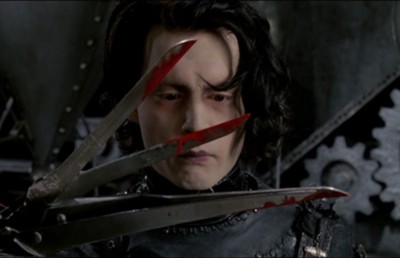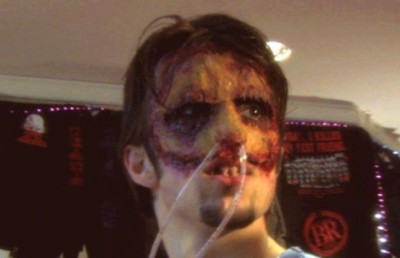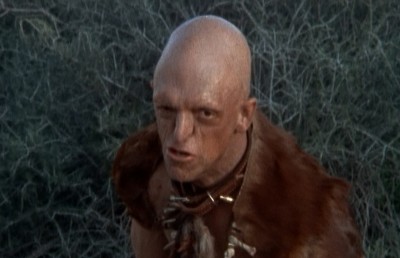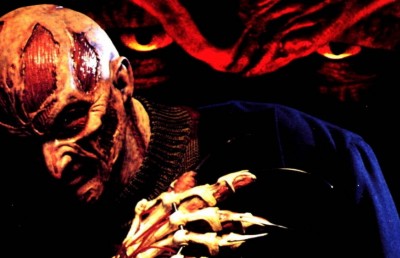Digging Beneath Shallow Ground
An Interview
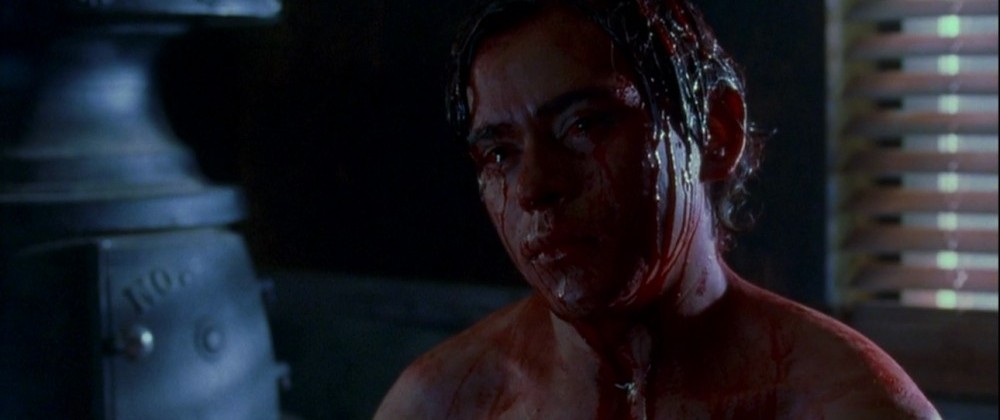
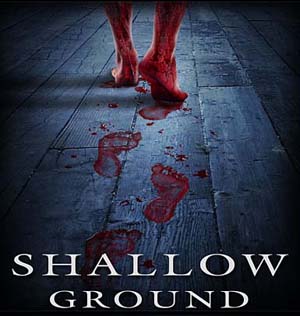
The recent horror film Shallow Ground (2004) is a breath of fresh air: It is not a remake. It is not a sequel. It does not feature one of the classic monster icons (vampire, werewolf, zombie, etc.), or a traditional serial killer. Nor does it feature characters caught in a survivalist scenario or being tortured. Nor does it poke fun at the genre, cast smarmy asides at the camera or reflexive postmodern winks. So what is Shallow Ground about? The film plays its cards right from the striking opening, which sees a nude, blood-drenched, knife-wielding boy walking determinedly through the woods. He enters the Shallow Valley sheriff’s office on the day it is being shut down by two young deputies, Laura Russell (Lindsey Stoddart) and Stuart Dempsey (Stan Kirsch). The menacing figure of the boy (played by then 24 year-old Rocky Marquette) remains silent while questioned by Sheriff Jack Sheppard (Timothy V. Murphy). We learn —through a nightmare which introduces us to the sheriff character— that the Shadow Valley area has been recently terrorized by a vicious murderer whose modus operandi includes slitting the victims and hanging them from a tree to exsanguinate. Everything suggests that the mysterious ‘boy’ is the killer, but when Sheppard has the boy’s blood analyzed a puzzling bit of detail is revealed: the blood covering the boy’s body is made up of the blood of a various people, some of whom have been dead for a year, and the knife is the same that was used to murder a local girl 12 months ago. Blood and the horror genre go hand in hand, but the thematic weight of blood in Shallow Ground goes beyond any other film I can think of. The boy is a walking stigmatic, bleeding out of every orifice; his blood moves about as if imbued with sentient powers that are connected to the victims and, indeed, nature itself, reflected through the nearby woods. But is the boy an evil conduit or an angry victim? The plot develops, laced with flashbacks bearing further gory details on the town’s violent past and a revelation teetering between the rational (some humans are revealed as killers) and the supernatural/unexplainable: is the boy a composite avenging angel for all the victims? Is he a symbolic manifestation of the town’s ‘evil ways,’ a ‘return of the repressed,’ or the town’s collective guilt? How far ranging is this evil contagion? The film refrains from a complete revelation on all counts, preferring to keep some of the narrative twists ambiguous.
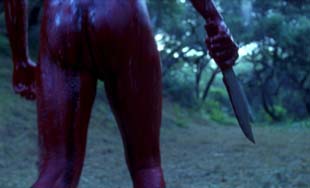
The following interview was conducted on July 23, 2004, with Canadian-born director/writer Sheldon Wilson, executive producer Bill Mendel, music composer Steve London, sound designer Richie Nieto, producer Martin Mathieu, and actors Rocky Marquette (as the Boy) and actress Natalie Avital (as Darby Owens). PS. There are a major plot spoilers in the interview. It is primarily intended for readers who have already seen the film.
Offscreen: This is the flagship film for Deco Filmworks, is that right?
Sheldon Wilson: Yes. There are four members in the group, myself, Bill Mendel, Martin Mathieu, and John Tarver.
Offscreen: Yes I noticed that Tarver was the cinematographer and producer, a combination you do not see too often.
Sheldon Wilson: No that is true.
Offscreen: Where did the funding come from?
Bill Mendel: From myself and a few friends.
Sheldon Wilson: Basically private equity. Bill went out and knew some people who were willing to come on board after they read the script. Bill really filled his role as executive producer.
Offscreen: In terms of the script how long was the germination period.
Sheldon Wilson: From the time where I came up with the idea to the time where I started writing was about three weeks. It was January of 2003. I wrote it and then we were shooting by about July. It all happened very fast. I did rewrites as I went along.
Offscreen: That is surprising because it is a fairly intricate plot.
Sheldon Wilson: I did the first two passes and then Bill took it and went looking for money. Once we were up and running we knew exactly what locations we could get. What stunts we can do, and what was available. Then we sat down with some members of the crew, Jim Goodman the first AD, and John Tarver, the producer and DP, and we spent about three days in pre-production. We did not storyboard the film, but we went through the script page by page deciding how we were going to do it, how long it was going to take, and then I went away for a couple days and did the rewrite. We knew that everything that was in the script was very doable.
Offscreen: Most of it was shot on location?
Sheldon Wilson: Yes we had three locations outside of LA. We shot at Topanga Canyon, the San Gabriel Damn, the Sanna Ranch, and then we spent a week in a studio in Van Nuys.
Martin Mathieu: And with the damn, being after 9/11, it was difficult just to get near water.
Sheldon Wilson: All the interior police cabin stuff we basically built in an afternoon on a soundstage. And because we didn’t have any money we didn’t pay for the air-conditioning. It was the first really hot day in the valley and I have never experienced heat like that in my life. The lights of course compounded to the heat and it was such a small stage. The air-conditioning was portable so even when we decided to cough up the $250 for the air-conditioning it could not happen until the following day so we had to rough it through for a few days. We shot for 21 days then we started cutting the movie and did two rounds of pickups. Each round took about a week so we had two additional weeks of shooting. It was great having a DP as part of the company, because it gave us the flexibility to go and shoot when we needed to shoot, and Panovision was very generous in donating a camera package, while Kodak gave us a free roll of film for every four that we bought.
Martin Mathieu: Our lighting package was also free. Then we would pick up the phone and call Rocky, who would come and get all bloodied up again! Same with Natalie. And there was one pickup shot with Natalie lying down where we had the flightless flies.
Offscreen: Oh that was the montage in the credit scene, right?
Sheldon Wilson: Yes that is her stomach we see in the opening montage, and then later on in the movie there is a scene where her stomach is crawling with bugs. I lied to her. I told her I would pick some flies up and put a few on her, which is what I was going to do, but when I took the off the lid it was swarming with flies and the camera was rolling so I just said, what the hell.
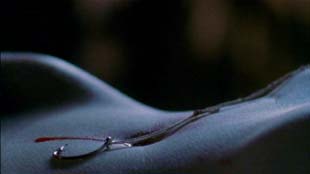
Offscreen: What were they?
Martin Mathieu: They were flightless fruit flies. It is true that they are flightless but they can jump.
Natalie Avital : And I had about 5000 on my stomach!
Martin Mathieu: We used them a few times during shooting and anyone who was around would get some on them. So they didn’t fly but they certainly jumped far!
Offscreen: You didn’t have a fly wrangler?
Sheldon Wilson: Don’t joke because, well, they charge a huge amount of money. We did not want to change this into a big production so we just went down to the reptile shop and bought them.
Martin Mathieu: Like the maggots, the flies were reptile food.
Offscreen: I read the film was shot on Super 16?
Sheldon Wilson: Yes. We are in the process of blowing it up to 35. We are doing a digital intermedia.
Offscreen: Was it all shot on Super 16?
Sheldon Wilson: Yes.
Offscreen: In terms of the title, Shallow Ground, was there ever a concern because of the 1994 Danny Boyle film Shallow Grave?
Martin Mathieu: Yes we get that a lot.
Sheldon Wilson: I am good with it. I wanted a title that was a little classy and they are two very different movies. Thematically it works because the dead are coming out. But I am sure a lot of people get the films confused just because of the titles.
Offscreen: The first flash memory that we see when Stuart Dempsey (Stan Kirsch) comes in contact with the boy’s blood, where there is this necrophilic moment in the woods, is that Stuart? Or is it the prisoner Harvey (Myron Natwick)?
Sheldon Wilson: It is Harvey. It is a young Harvey.
Offscreen: Gosh he looks like such a quiet, calm guy sitting in the prison.
Sheldon Wilson: You mellow with age I guess!
Offscreen: There is not much humor in the film, which is something I like, because in the late 1980s we had all the serial killers that became pranksters so it is nice to have a character, the boy, that not only does not joke but does not even talk. Until near the end. But there is some dark humor in this scene, in the fact that the Sheriff Jack lets Harvey out of the cell and asks him to help in the case. It shows the small town ethics I guess; or maybe it is another slight on Jack’s decision-making skills!
Offscreen: When you introduced the screening last night you mentioned three key films: The Shining, The Exorcist and The Thing. On the surface the influences are not that apparent, but if you look a bit further or if you see the film more than once you can start picking them up. I noticed with The Shining there is the telepathy and the blood writing; with The Exorcist there is the scene where the boy talks in Amy’s voice to play on Jack’s guilt of not having saved Amy, which parallels the scene where the demon speaks in the voice of Father Karras’ mother. With The Thing there is the blood, the transfusion, and the shape shifting.
Sheldon Wilson: And don’t forget that Rocky pukes blood! Probably my all-time favorite horror movie is Jaws. That is a film which does not always get put into that genre but I think worked really well. And The Omen and The Amityville Horror.
Offscreen: Another film which fits in with your film is Frailty, which I think is one of the best American horror films in a longtime. I think there are a lot of connections to your film the way the flashes are used and the telepathic links between the past and present. Have you seen that?
Sheldon Wilson: Oh yes I love that one. That is a very intelligent film.
Martin Mathieu: I think Sheldon has a very dark sense when he is writing. People will ask him how he gets his ideas and when they ask me I have this ongoing joke, by replying, “Well I don’t really know, but if he did not go home to his wife and two kids I would really be concerned…. were is Sheldon and what he is he doing at home!”
Offscreen: And because I’ve seen far too many horror films…the scene with the blood oozing under the door reminded me of a scene from Jacques Tourneur’s The Leopard Man. One of the most famous scenes from that film is where a little girl gets killed in the woods and we see blood coming from under the door. You have that a few times in your film.
Sheldon Wilson: I have not seen it, I don’t think.
Offscreen: The mother figure who ends up being the killer also reminded me of Friday 13th and Patricia McCormack actually looks a little bit like the mother from Friday the 13th, Betsy Palmer.
Sheldon Wilson: I agree with that but it must have been a subconscious thing because I really wanted that the audience would not figure it out until the end. And it felt like a really good way to trip the audience. The difference from Friday the 13th I think is that Friday the 13th does not give you the chance to figure it out.
Offscreen: Yes that is true.
Sheldon Wilson: There were a lot clues in there to figure it out.
Martin Mathieu: There is foreshadowing in there for sure. As I think of it, one of the Friday the 13th films was shot where we shot, in Topanga Canyon, I think it was Part 3. And definitely Pumpkinhead was shot there too.
Offscreen: In the first scene where we see Patty McCormack (character of Helen Reedy) talking to Darby Owens (Natalie Avital), after Darby leaves, the camera stays on Patty for a while and she has this expression on her face which in hindsight might have been a clue. That little edge of something being slightly off kilter about her can be seen as a foreshadowing of sorts.
Sheldon Wilson: Patty was awesome because it is a very difficult thing to do, to plant the seed without giving it away.
Offscreen: Just some general questions for Rocky and Natalie. Maybe some background on your acting.
Natalie Avital : Most of my training has been in theater. I went to theater school and I had been doing theatre for years, and the last couple years I have been doing films on the indie circle and festival films.
Rocky Marquette: I started doing puppet shows from when I was seven. After I ended high school theater I then was on a Shakespeare scholarship so I studied a lot of Shakespeare. And then I decided to move out to Los Angeles and give it a shot.
Sheldon Wilson: We cast it for a long time and looked at a lot of people for all of the roles. Again because we were not paying it was harder to get really top-notch people so I felt if we just kept looking, since we were in Los Angeles, we would find some good actors, and we did.
Offscreen: It must have been nice casting Patricia McCormack, who starred as the little evil girl in The Bad Seed (Mervyn LeRoy, 1956).
Martin Mathieu: I know that on the set I was watching her do her stuff and I was kind of in awe.
Offscreen: Natalie, had you seen The Bad Seed before you acted with her?
Natalie Avital: I had seen it a long time ago and just the other day I saw a photo of Patty when she was 10 years old in a local weekly here, The Mirror.
Sheldon Wilson: For that death sequence at the end she spent a total of about 30 hours in makeup. She would sit in the chair and then we would shoot for 10 minutes and she would go away and would take the makeup off.
Martin Mathieu: It was eight hours of makeup, then 10 minutes of shooting, eight hours of makeup, 10 minutes of shooting.
Sheldon Wilson: You get to a certain age and there are certain roles that you just cannot get to do all the time so she really embraced it and got a kick out of it.
Offscreen: Talking about makeup, Rocky I don’t think I would have recognized you if I had seen you right after the film because you worked with so much makeup that it was hard to get a read on your facial features. It was you in that role right!
Rocky Marquette: Yes (laughter all round).
Martin Mathieu: Now he is just this cute kid.
Offscreen: Is there anything else in terms of how you got into your role? Because your character has this symbiotic link to Jack and to the woods.
Rocky: It was fun because I took every single character and had to go through all the situations they had have gone through in the script. I just went back and forth between that and meditated on that for a couple hours and then it just came.
Sheldon Wilson: And all the stuff of Rocky when he gets to perform things sitting at the desk, the stuff where he is speaking, where he is throwing up and it looks like his eyes are going to pop out. We did that on the last day. We were running late and had to shoot that pretty fast. The guy who owned the sound stage told us, “guys you’re into overtime and you have to go,” because it was our last day and we had to shoot all that really fast. So all that stuff happened in half an hour.
Offscreen: In the scene where Darby gets attacked in the medical van, was it a real van?
Sheldon Wilson: Yes it was just propped up, jacked up.
Natalie Avital: I had wild stirrups around my legs and the van was just raised.
Martin Mathieu: She was walked through the scene with the stunt coordinator.
Natalie Avital: The stunt coordinator was great. For the scene where I am hanging from the branch they had this box and between takes they would throw the box in for me to rest on. It was a little wild when I was hanging, but I was hanging.
Offscreen: Your character, Darby, dies at the end and becomes a member of Helen’s “family,” but I wonder why she died because she does not seem to deserve it.
Sheldon Wilson: Helen started out killing for a very particular reason, because of her daughter’s death in the damn accident. But then she begins to get into it and begins to build a new family and now she discovers that the remaining daughter figure, Darby, who was a friend of her daughter’s, is now leaving her. It just becomes more than what it started out to be.
Martin Mathieu: Because there is that scene, the first scene where Helen and Darby come together in front of Helen’s inn, and Helen asks Darby, “When you pull out tonight, would you come by here. I have some family stopping by and they would love to meet you.” It was like, “come by for dinner to meet my family,” because she realized she would have this family later. Which is a foreshadowing device.
Offscreen: You mentioned after the screening that the image of Rocky running through the woods all bloody is what sparked the idea of the movie. Can you talk a bit about how that spread out into the film?
Sheldon Wilson: I’m not sure where it came from but I just had this vision of these little drops of blood in the snow and then you go from that to the footsteps and then you see the bloody feet, the bloody legs, the bloody knife, and then we see the bloody boy walking. I just thought that was an amazing image and then I pitched it to John Tarver because John and I were teaching together at USC at the time. He thought that it was a great idea, but how would you get someone covered in blood walking in the snow? And I thought, oh right that could be a problem. I really liked the idea of the Rocky character playing different characters. Then there were these outside influences I guess, with the fingerprints and the popularity of CSI.
Offscreen: I like the idea of the boy representing the revenge of the dead or the collective souls of the dead. And also his connection with nature and the woods. He is a composite character whereas the other bloody returner, Curtis, is not a composite.
Sheldon Wilson: That is right.
Offscreen: Does that mean that there are different types of bloodied people or returners?
Sheldon Wilson: Well if you kill five people then when you send someone back they will look like those five people. If you have only killed one person, which was the case with Stuart, the returner is going to come back and look like that one person.
Offscreen: I’d like to talk about the scene where Detective Ray is on the telephone with Laurie. I really like the way you used depth of the field. Throughout the film, on at least five occasion, you have characters in the deep background of the shot and it is very subtle because you have to be looking in the background to notice them. In this scene you have Curtis in the background cuffed against a wire fence and the first few times you barely notice him, with Ray on the telephone in the foreground. One of the effects of this is you get the sense that this is an epidemic. Did you put that scene in to make it to feel like this action was occurring in more than just Shadow Valley?
Sheldon Wilson: My idea was that it was definitely larger, that it was happening everywhere in the world. But given the scope I did not want to reach too far for our capabilities. There were a couple of more scenes in the city but I thought it was better to just focus on what was going on in Shallow Valley and just hinted at the widespread of it. I think most people get that because there is enough there to tell them this is going on in more places than just Shallow Valley. I would like to have the opportunity to explore that more in a sequel!
Offscreen: It is also nice because with the Ray character or the Stuart character you never get a sense that they are good or bad characters. In fact I like the way the characters are written because they are not all just black or white.
Sheldon Wilson: One of my favorite films is Unforgiven (Clint Eastwood, 1992) because that is a movie of gray where everyone is a little bit good and a little bit bad, and that is closer to real life.
Offscreen: In terms of Helen’s method of slaying her victims, why do you think she hangs her victims? It is a nice visual effect, but is there anything more to that?
Sheldon Wilson: Yes. Initially she would hang them because she did not want to dirty up her inn. She would hang them up outside and then leave them out and take them back once they were bled and embalm them. Plus out in the middle of the forest it is less likely that anything is going to happen or that anyone is going to stop by. That was her thinking: hang them up to dry, take them in, embalm them, and stitch them up.
Offscreen: A bit like Norman Bates. There is a bit of Norman Bates in all of us! Along the same lines the hunter character is another one of these ambiguous figures.
Martin Mathieu: A red herring.
Offscreen: I like the editing during the scene where the hunter sees Darby tied and hanging from the tree in the middle of the woods. The first few times you are not sure what the physical proximity is between the hunter and Darby, who is in this very vulnerable position hanging in her underwear. You think he is looking at her and it is only a while into the scene that you realize the physical distance between them, which makes it more suspenseful because you fear for Darby’s safety. Because if he is seeing her you wonder, why isn’t he rushing over to help her? So somewhere in your mind you are thinking maybe he is waiting to go over and do something nasty to her.
Sheldon Wilson: I really have to say that was a conscious effort because of a sequence in Silence of the Lambs where the SWAT team is going to the house. I thought that was the best use of parallel action I’ve ever seen to build tension. That was definitely on my mind.
Offscreen: That really works because we are used to seeing it used conventionally. Martin mentioned how hard it was to get near water after 9/11. There is a wonderful line that the boy says in his possessed voice: “These are not sensible times Jack.” To me that line is very resonant. Was that something you wanted to reflect the political landscape today?
Sheldon Wilson: No, I don’t know if I was directly referring to 9/11, but again it was definitely at a time where there were a lot of heavy things going on. I have two young kids too and a lot of those things like Columbine were on my mind.
Offscreen: What I also like about the film is something you do not see too much in horror films, especially low-budget ones, the interlocking vengeance motifs. You have Amy’s father, Albert, mad at Jack because he did not save her daughter; Helen is mad at everyone involved with the Damn Project, which caused the deaths of her daughter and husband; Curtis seeks vengeance against Stuart. You have all these interlocking revenges.
Sheldon Wilson: Yes there is a lot of revenge going on!
Offscreen. I guess you can say that relates to Unforgiven?
Sheldon Wilson: Yes very much.
Offscreen: Yesterday at the screening somebody asked you about the ending and you said that was the one point in the film where you were consciously not trying to be clear.
Sheldon Wilson: I will explain every other single moment in the movie except for that last scene. I will eventually.
Offscreen: So you did not write it simply to have an ambiguous ending. It does have a possible meaning in your own system of thought?
Sheldon Wilson: Yes.
Offscreen: I saw the film last night on the big screen and I saw it again this morning on tape, and I paused it when the character pops out from behind the tree and looked at it closely. I thought maybe it could be Helen because her makeup when she dies makes it look like she has transformed into a zombie. Her eyes are like eggshells and part of her facial skin falls off. And that maybe because, as her character says, she already died a year ago when she lost her daughter and husband, that at death she automatically becomes a putrid year-old corpse. Which is what the character that pops out at the end looks like. But there are many ways of looking at the ending. Maybe I’ll ask you, Rocky and Natalie, what you think the ending is about?
Natalie Avital : We were actually working that out today coming up with our own theories but I am going to take the Fifth on that right now!
Offscreen: I guess another way to look at the ending is that because the boy character also has this mythological element, if you keep the final figure vague it maintains that, rather than saying it is that person or this person.
Offscreen: I would like to bring Steve London [musical composer] into the discussion as well because one of the things that gives the film more production design value, along with the makeup which I just mentioned, is the sound. The sound comes and goes in interesting ways. I imagine you looked at the film first and then composed the score?
Steve London: So as not to hog all the glory I think you have to bring in Richie Nieto, who did the sound design, as well.
Richie Nieto: There is a lot of Foley in the film unlike most low-budget films which get all the sound effects off of CDs. This film is pretty unique in that way. We actually went out and recorded a lot of sounds. What I noticed about low-budget films is that they use one person to do pretty much all the sound. They will compose the music and also produce the sound. So I think it is a luxury in a way to have two people doing their own separate things. And communicating all the time. With a big budget film of course there is a whole group of people just working on sound. There may be between 20 and 30 people just on sound.
Steve London: At the beginning we started saying if this is going to really work, if this is going to sonically happen, we need to do the orchestra in 5.1 sound. I think Bill [executive producer] went and returned all of his empty bottles and sold his bike, I don’t know what he did, but he managed to scrape together the money for us. Which enabled us to use the orchestra which I use a lot in Budapest, Hungary. I got this crazy starfish microphone that hangs over the orchestra and recorded it all in surround sound.
Martin Mathieu: The sound in the movie that I love is that one instrument, the contrabass clarinet.
Steve London: When Sheldon and I were talking he was saying that he wanted the sound to be very low. Those were the rules: he did not want any melody and he wanted it low. No nice themes. So I am sitting there and thinking we’re going to Hungary and Hungary is a great place to record, but it used to be an Eastern Bloc country, so what are the chances of getting all these interesting, crazy things? I call up the contractor and tell him I want a contrabass clarinet for this idea of a duet between a contra bassoon and a contrabass clarinet, way down at the bottom. The contractor is skeptical. Then he calls me back and says there is one contrabass clarinet in all of Hungary, and it does not work. So I asked what can you do to make it work. He calls me back a couple days later and tells me that they found all the parts, patched it up, and brought it into the studio. We used it and it was great because we had one on the left side and the other on the right and was able to get a panning effect by played them together and fading them in and out. And the result is this low sonic thing which was a lot of fun for me to write but also sounded very cool.
Sheldon Wilson: We did the sound in a very different way. Usually you’ll cut your film and you get a picture lock which means you are not going to do anymore editing. And then you give it to the sound guy. And then to a composer. And they will start working. But as I would finish reels I would cut 20 minutes of the movie and would hand it over and the sound guys would start working on it. Knowing that I would go back and do more edits. So when we went to Budapest to use the orchestra, Steve had to figure out a way to do it so we could change it because I still needed to be able to change the movie because it was not locked yet. So he split it up into all these different orchestras and figured out a way to do some on the computer.
Steve London: I would write eight bars orchestrate it and that was it. I would leave a space in between and we would go to another queue with some big stuff, like a car crash and we would go for eight bars and then in the afternoon or the next day we would have only strings and the part after the car crash with the same queue. So the recording of it took two days but we did it really fast and that is all we could afford. And then I spent two months editing it on a computer. Which is why it is much cheaper. That is where Richie and I really got to work together, layering it, cutting and pasting it and getting all of my original sketches to look like it was supposed to in the movie. Getting all the textures together and really getting the balance with all the sounds.
Offscreen: I like that play between sound and music early in the film when the hunter drives up and we are in the police station. You hear this offscreen rumble and it turns into the van driving up to the station outside. One of the thematic sounds or effects that comes and goes is the sound of the knives shearing or being rubbed together. How did you get that effect?
Richie Nieto: That is actually quite a recipe. That was achieved with a sword and a kitchen knife. One of the swords is actually from a CD library and the kitchen knife was recorded live. One of them is reversed and I added some reverb to it to make it tail and then you re-reverse it so the tail comes before the effect and it sounds like a slashing sound.
Offscreen: It is never as easy as it sounds!
Richie Nieto: Something very funny happened during the pickups. When Lindsey [Laurie] is driving in her car and she drives over the puddle of blood that splashes up and causes her to crash, we did not have a shot of Lindsey hitting the side window. I called Sheldon and said it would be really cool if we had a sound of Lindsey hitting the window. I really want to use the sound of her head hitting the window.
Sheldon Wilson: Yes so I went out and did the shot so he can get the sound.
Richie Nieto: So it worked backwards. I’m pretty sure that Lindsey must hate me by now. I did not use the real sound of the head hitting the window. I used a fish bowl.
Offscreen: I guess in cinema the real sound does not sound as realistic. In terms of the style in general I found the first 20 minutes was grounded in realism and then as the film developed it became a bit more stylized, with the flash memory shots, the quick montages, the shaky, “Jacob’s Ladder” effects. Was that a conscious choice or was it a result of the way the story developed?
Sheldon Wilson: I wanted to start off the film very grounded just to get people invested in the characters and then the more we learn about the bloody boy the more supernatural it becomes. We begin to bring in some of the more traditional horror elements especially once we start getting into the vision sequences. The palette starts to grow and it starts to become a little bit more strange, a low bit more odd, so I wanted the style to go there.
Offscreen: In one of those of vision sequences there is a double exposure effect where it looks like there are two killers. Was that done in camera or optically?
Sheldon Wilson: I did that as an effect. It was two shots and then fused optically.
Offscreen: How did you design the frock the killer wears? I thought the way the killer was dressed was very creepy.
Sheldon Wilson: Again the simplest thing became the most difficult. We could not find a jacket big enough with a deep hood and when we found one that was deep enough it was not black. Again when you are in Los Angeles you get used to being able to find everything you want. You just keep looking for it. So we had our costume designer take it and dye it. Then it became like plastic surgery, cutting parts off and stitching parts on. It was pretty low-tech, just a windbreaker and we pulled a dark stocking over her face.
Offscreen: It worked well. The double exposure helped well in terms of making the killer’s identity less clear. Just to get back to the way you use the background of shots. It is something used very often in horror movies to get audiences involved because they are able to see information that characters in the foreground do not. There are at least five shots like that. The first one is where Stuart is putting boxes away in the car and we see the boy move past him in the background. It looked like the boy was floating by on a dolly because he moved so quickly.
Sheldon Wilson: It is the weirdest thing, he actually just walked.
Offscreen: How did Rocky walk that way, it was like a moon walk or something!
Martin Mathieu: The first time I saw that I could not believe it. Rocky would hold himself in a certain way and hold his upper body so rigidly.
Offscreen: Well that surprises me because I thought for sure there were some mechanical element involved in the movement.
Sheldon Wilson: Thematically, like what you are saying, it works great and it saves time from a production standpoint too. I think the best example is when Timothy [Jack] comes in and Nancy is mopping up and they stand there and have the conversation. She never really looks at him, and they are “stacked up” [lined up in depth] and again I think it works because it was a situation where we were running out of time and I just needed to get the shots. So whenever we would run into a situation like that a lot of the times we would stack them up in depth. The same as when Timothy wakes up on the couch and Stuart comes in the back. It was a way of getting everything in one shot, plus having to edit less and stay true to the moment because there were a bunch of things going on there.
Offscreen: Yes I would agree that shot counter shot tends to break things up. Related to that is the film’s time structure. The film almost moves in real time, not quite, but it starts in late afternoon and ends at night time. We don’t get any night scenes until toward the end. It may be a little bit more expanded than real time but not by much. That also makes the film feel more claustrophobic. And more intense because of the time pattern. Was that also a conscious design of the script, to make it feel as if it is almost real time?
Sheldon Wilson: Yes I just wanted it to be one day. I wanted all this stuff happening in one day and to me when you start in bright sunshine and you work your way into night it just becomes more claustrophobic. And there is that tiny little release at the end of the film when it is morning again. Again that is another reason why I really like The Thing because it is so claustrophobic. I like it when you have people who are left in a situation with no chance for outside help and they just have to figure it out. The Abyss too. When I first saw that movie I really loved it because again you have people in a situation which they just have to figure out for themselves.
Offscreen: I’d like to talk about the makeup. I like the hideous grin effect which the victims end up having. I don’t know if you have ever seen the 1928 film by Paul Leni, The Man Who Laughs starring Conrad Veidt, which has this image of his face with this distorted perennial grin. As a baby the Veidt character had his mouth cut into that hideous grin. And he wears a half mask to hide it for most of the film until it is unmasked at the end. The grins of the dead victims in your film reminded me a lot of that. Was the makeup all done conventionally?
Sheldon Wilson: There are only two shots in this film that are digital and everything else is physical effects, by Patrick Magee and his assistant Saul Gallegos. I would rather see a bad physical effect than a really good digital effect in a horror movie. There something about it that makes it feel more real. So Patrick was awesome in that respect.
Offscreen: I imagine the spider was one of the CGI effects?
Sheldon Wilson: Yes there is the one shot with the spider moving across Rocky’s eye, and the wider shot where they are scurrying across his chest.
Offscreen: So all the blood effects were done in camera?
Sheldon Wilson: Yes. We put all the lights and all the bits and pieces of the furniture and everything in the corner on big pieces of heavy duty foam. The camera is on there too so the only thing that you can see moving is the blood. We poured it on and we had four people push down and the blood would go where we wanted it to go. It looked like everything was still but the floor was a mess. Martin is the feet of all the actors that you see.
Martin Mathieu: Once again we were thinking of how to do the blood effects for months, coming up with all these crazy contraptions and it turned out to be the simplest thing: building this 12 foot by 12 foot and then getting the thick foam and attaching everything to it. People think that it is CGI blood, but it is not!
Offscreen: Do any of you have a favorite moment or favorite scene from the movie that you’d like to talk about from any perspective, sound, directing, acting?
Steve London: The one that worked really well for me and I’m not sure where it came from, maybe by accident, is when Jack first interrogates the boy, especially the moment when Rocky turns his head slightly away. Originally I thought of this idea of a sound going down. They did not play it properly in Budapest because they were so rushed and I did not catch it, but it actually ended up working much better than I had hoped because you have this swell and as they stop playing it dropped just a little bit in pitch and for me it works so well with Rocky’s little head movement. I was really pleased at how it worked out. Tim and Rocky are so great in that scene that there was very little for me to do so I was happy to do a little bit here and there and have their performances speak on their own.
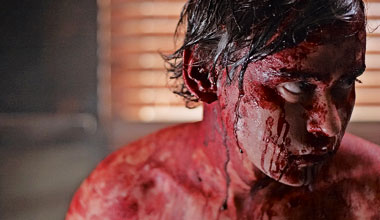
Offscreen: It is almost as if Jack is trying to goad the boy into hitting him or doing something to him.
Steve London: Exactly and then there is just a little turn of the head.
Rocky Marquette: For me it is the opening title sequence, which is one of the best I’ve ever seen. The combination of the music and the cutting. It just catches you unexpected right at the beginning.
Natalie Avital : There is one moment that cinematically is so beautiful to me is when Tara [Amy Underhill] is lying on the ground in the foreground and staring off camera and then behind her to the right we see the dark figure of the killer. It is so done so classically and there is something so horrifying about that moment to me.
Offscreen: It is like being trapped in a nightmare where you can’t scream. Or like that classic Halloween shot where Laurie is in the foreground and Michael Meyers is lying presumably dead in the background and then arches his body forward… and the music starts.
Sheldon Wilson: Same moment as Steve actually. The first time that Jack talks with the boy I really think there is so much going on there, so little is being said and it is such a quiet scene. I wasn’t sure if I was going to be able to get away with using all of it. I wondered if it would make it too slow, with the boy not say anything and having all the conflict implied. I do not know how, but Rocky was so compelling. You cannot take your eyes off of him and with Tim [Jack Sheppard] you could see there was so much going on with his eyes, where he was thinking and working. I get sucked into that scene every time. I’ve seen the movie a gazillion times and if we are doing something and that scene comes up I will automatically get lost in it.

Richie Nieto: I terms of sound one scene I am pretty proud of in particular is the exterior scene when Darby is in the medical van just before she gets snagged. That was a tough scene to do and took me a long time. Usually you are trying to clean up the exterior sounds so the dialogue lines are clearer but in this case we actually needed to add a generator in the background, which was like adding noise to it. I wondered how I would make this work with the generator playing in the background and still needing to have every single note, the needle going into her finger and the drop of blood falling onto the microscopic glass. With all of these small sounds it was a case of having to build up a very tense moment until the point where she gets dragged under the van, and that took a long time.
Bill Mendel: When Rocky slices into Helen’s neck….. every time I just can’t watch it.
Offscreen: Any final anecdotes? Anyone single anecdote that defined the shoot?
Sheldon Wilson: It was really amazing because again everyone worked for free. There were long 12 hour shooting days but we really moved and did a lot of setups. It was pretty intense. We spent the first nine days in one location and by then pretty much everyone and everything was covered in blood. It was a tough location and then we had to move quite far to the damn. I really thought driving up to the damn that we would get there and there would be no crew! And we would show up and they were all there, and it was WOW! It really became this tight knit family and I think we still are.
Martin Mathieu: Everyone still keeps in contact. You can pay someone to do things but if people come because it is something they believe in, something they are passionate about. Every person has something that they do but it all comes from a place of passion and every day it became a place to come to funnel that into and that is what made it such a great experience.
Sheldon Wilson: I think of big part of it to was that on the off days we would send the crew and everyone home and then the producers would come in and wrap all the cable and all the lights, pick up all the garbage, move all the vehicles to the next location, so that when everyone came back and we were all smelling like garbage it was like, all right, they are getting their hands dirty too.
Martin Mathieu: Definitely it was above the line, the crew was just willing to go that extra distance. John Tarver our DP was gaffer, grip, first AC. He did everything. The director was production designer and helped build the set.
Offscreen: It was obviously a non-union shoot.
Sheldon Wilson: Yes except for SAG. They let us do it without paying the actors but as soon as we sell the movie we need to pay them.
Offscreen: Well that is fair enough. Thanks so much.
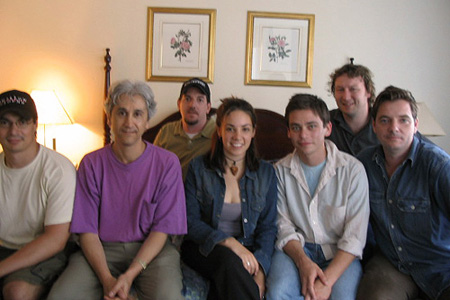
Shallow Ground Official Website



